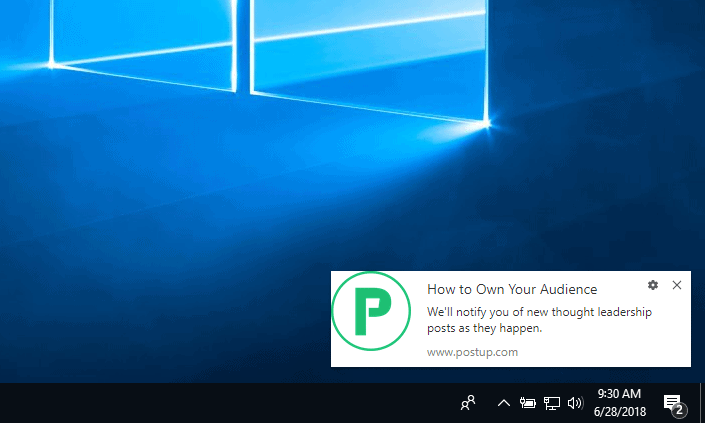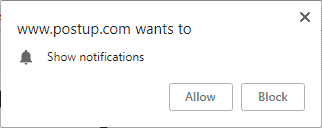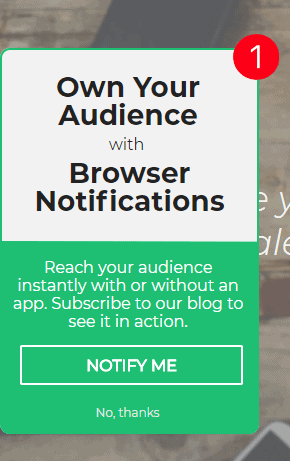Looking for another way to connect with your audience? Look no further than browser push notifications. When direct relationships with your audience are a must, browser push gives you one more opportunity to kick off these all-important relationships with your passing site traffic.
If you’re considering implementing browser push, you probably have a few questions about what it takes to venture into this new channel—which is good. It’s important to get your browser push strategy right; otherwise, you could undo your browser push efforts before you send a single notification. A recent Publishing Executive article discusses the pitfalls of a haphazard push strategy.
We want you to avoid those traps, which is why we’ve compiled a quick FAQ to answer a few of the questions you might have about browser push.
What are browser push notifications?
Browser push notifications are push notifications deployed through a user’s —you guessed it—browser. With browser push, you can reach your audience directly and immediately, even when they’re not browsing your site.
What’s the difference between browser push and app notifications?
For the user, virtually nothing. They function just like an app notification, buzzing your user’s pocket and popping up on the lock screen practically as soon as you send it.

For you, the big difference is that you don’t need an app to send browser push notifications. That means two things: you don’t have to invest in developing an app, nor do you have to convince users to download it.
On average, a publisher’s app is only downloaded by about 5% of their audience. It’s unlikely that all of a publisher’s app audience receives notifications, so the actual reach of your app push notifications is even lower.
Meanwhile, browser push can command an opt-in rate of more than double the average app download rate, giving you far greater reach without the technical investment of an app.
So you don’t need an app to send push notifications?
Nope!
What devices support browser push?
Another key difference between browser push and app push is that browser push works on both desktop and mobile. While browser push notifications appear on the mobile lockscreen, browser push notifications on desktop pop up on the corner of the screen.

Like so.
As long as your user’s browser supports push, you have the opportunity to connect with them. And considering all of the major browsers have stepped up to offer browser push support, the odds are in your favor.
What are some other benefits of using browser push?
In addition to a massive potential audience and cross-device support, we covered a few browser push benefits in an earlier post. To sum up:
- Browser push gives you instant access to your audience, no matter where they are, allowing you to deliver content directly to your audience.
- With browser push, you don’t have to deal with social media algorithms or the potential deliverability challenges posed by email.
- It presents a lower-hurdle opt-in to your visitors, who don’t have to download an app or give up their email address to receive your content.
How do users opt in to push notifications?
To initiate the browser push relationship, the browser displays a native dialog asking users whether they would like to allow push notifications from the site they’re currently viewing.

You’ve probably encountered this dialog dozens of times. It’s that dialog you’ve probably seen the second you hit a new site. Unfortunately, deploying this opt-in dialog immediately after loading a page can cause publishers to miss out on conversions.
This native opt-in dialog forces visitors to make a choice: sign up to receive push notifications, or block these notifications completely. Problem is, these new visitors haven’t seen your content yet. How will they know whether they want to opt in if they don’t know anything about you? More likely than not, they’ll err on the side of caution and choose block.
When unblocking notifications requires users to dig around in the hidden corners of their browser settings, this likely means they’ve blocked your push content forever.
How can I grow my browser push audience more effectively?
 The best way to grow your browser push audience is to make sure your site visitors don’t see that opt-in prompt until they’re ready to convert.
The best way to grow your browser push audience is to make sure your site visitors don’t see that opt-in prompt until they’re ready to convert.
But how do you know when they’re ready to convert? When they tell you they are.
That’s why it’s best to deploy an initial call-to-action that asks visitors whether they would like to receive notifications.
If they say yes to this initial CTA, you can show the opt-in dialog. If they decline, you still have a chance to ask them again, perhaps after they’re more familiar with your.
By allowing users to trigger the browser dialog themselves, you decrease your chances of earning a quick block and increase your odds of (eventually) earning a browser push conversion.
What kind of push notifications should I send?
Browser push is good for getting news out immediately. The kind of news you share will vary based on your business. For ecommerce sites, that might be news about a flash sale.
Publishers might also offer flash sales on premium subscriptions, but on a day-to-day basis, browser push is typically used to put content directly in front of the audience. Of course, because browser push is a direct link to your audience, you don’t want to abuse the privilege. You might publish hundreds of pieces of content each day, but it’s best to reserve push for the most important breaking news or your top articles of the day.
Is browser push free?
While some companies offer the ability to send browser push for free, the truth is that these free options typically make money by selling your audience’s data. That means your users end up footing the bill.
Before rushing out to implement a browser push solution, make sure their data practices don’t push away your users qho have privacy concerns.
Does PostUp support browser push notifications?
Yep! Check out our quick guide to see why the PostUp browser push solution drives more opt-ins, more engagement, and more direct connections with your audience.

